Bratislava
![]()
This article is about the city. For other meanings, see Bratislava (disambiguation).
![]()
Preßburg and Pozsony are redirections to this article. For other meanings, see Preßburg (disambiguation). For the Hungarian painter, see Jenő Pozsony.
Bratislava (![]() ['bracɪslava], until 1919 Slovak Prešporok, German Pressburg or before the 1996 spelling reform Preßburg, Hungarian Pozsony) is the capital of Slovakia and with 440,948 inhabitants (as of 31 December 2020) the largest city in the country. It is located on Slovakia's southwestern border at the border triangle with Austria and Hungary, making it the only capital in the world to border more than one neighboring country. At around 55 km as the crow flies, Bratislava and Vienna have the smallest distance between two European capitals, apart from the Vatican, which lies within Rome.
['bracɪslava], until 1919 Slovak Prešporok, German Pressburg or before the 1996 spelling reform Preßburg, Hungarian Pozsony) is the capital of Slovakia and with 440,948 inhabitants (as of 31 December 2020) the largest city in the country. It is located on Slovakia's southwestern border at the border triangle with Austria and Hungary, making it the only capital in the world to border more than one neighboring country. At around 55 km as the crow flies, Bratislava and Vienna have the smallest distance between two European capitals, apart from the Vatican, which lies within Rome.
As the political, cultural and economic centre of the country, Bratislava is the seat of the government of Slovakia as well as the location of several universities, museums, theatres and other economic, cultural and scientific institutions.
The history of the city has been shaped by numerous ethnic groups and cultures with different weights, such as Celts, Romans, Germanic tribes, Avars, Germans, Magyars, Jews and Slovaks. Throughout its history, Bratislava was one of the most important economic and administrative centres of Great Moravia, the Kingdom of Hungary (also within the Austrian monarchy and Austria-Hungary respectively) and Czechoslovakia. The city was the capital of the Kingdom of Hungary from 1536 to 1783 and in 1848, and the capital of the (first) Slovak Republic from 1939 to 1945. In 1968, Bratislava became the capital of the constituent state of the Slovak Socialist Republic (Slovak: SSR) in the Czechoslovak Socialist Republic (ČSSR) and briefly (1990-1992) in the Czech and Slovak Federal Republic (ČSFR). Since 1993 it has been the capital of the independent state of Slovakia.
The symbol of the city is the Bratislava Castle; a fictitious castle with three towers appears on the coat of arms.
Geography
Location
The city is located in the southwest of the country, in the Bratislava district, at the Slovak-Austrian-Hungarian border triangle. The Austrian border is five kilometres to the west from the centre, the Hungarian border 20 kilometres to the south. The border with the Czech Republic is 62 kilometres to the north. Vienna, the capital of Austria, is 55 kilometres west of Bratislava. Both cities are also known as Twin City and form the centre of the European region Centrope. The capital of the Czech Republic, Prague, is located about 290 kilometres to the northwest and the capital of Hungary, Budapest, 165 kilometres to the southeast (both measured as the crow flies).
Bratislava is situated on both sides of the Danube (Dunaj in Slovak), which flows through the city from west to southeast and is between 200 and 300 metres wide in the city area. In the western part of the city lies the Devínska brána, the valley between the Braunsberg on the southern, Austrian bank and the Thebener Kogel on the northern, Slovak bank. At this point, the Morava River, coming from the north, flows into the Danube; the estuary of the Morava River includes a small part of the Záhorie landscape, which geomorphologically belongs to the Borská nížina lowlands and thus to the Vienna Basin. The Bratislava Castle (Pressburg, 212 m a.s.l. ) in the centre of the city marks the beginning of the mostly north- or left-bank Slovak Danube lowlands (Podunajská nížina) in the Little Hungarian Plain, to which the eastern and southern parts of the city area extend. South of the harbour bridge branches off the Malý Dunaj, a left branch of the Danube in the Danube lowlands, and together with the Danube forms the Žitný ostrov. About three quarters of the city area belong to the lowlands.
The rest of the neighbourhood is characterised by mountainous landscape: The Carpathian mountain range begins in the Bratislava city area with the Theban Carpathians, the most southwestern section of the Malé Carpaty. In the area of the Lamač Gate (Lamačská brána) begin the Bösing Carpathians, which include one of the city's landmarks, Mount Kamzík (439 m a.s.l.). Several streams rise in the mountains, of which the Vydrica is the largest and the richest in water. In the north-west of the town, the Mláka stream collects streams in the Morava river basin, and in the north-east, the Račiansky potok stream with its tributaries via the Šúrsky kanál (Šúr canal) belongs to the Čierna voda river basin. The town covers an area of 367.66 km², making it the largest municipality in Slovakia in terms of area. The lowest point of the city area is at 126 m a.s.l. on the Danube near Čunovo, the highest point is the peak of Devínska Kobyla at 514 m a.s.l..
Along the Danube there are several arms, which continue to exist even after the completed river regulation. Downstream these are Devínske rameno, Karloveské rameno, Pečnianske mŕtve rameno, Chorvátske rameno, Biskupické rameno, Jarovské rameno, Rusovské rameno and Mošonské rameno. Between the Karloveské rameno and the Danube lies Sihoť Island, which is important for Bratislava's water supply. In the south of the city, the Danube opens to the Hrušov reservoir, which is part of the Gabčíkovo hydroelectric power plant complex. Near the state border with Hungary at the Čunovo weir, the Moson Danube branches off from the main river.
There are several protected areas in the city, including two protected landscape areas (Chránené krajinné oblasti) in the Malé Karpaty to the west and north of the city and in the Dunajské luhy on the southern edge of the city, as well as nine smaller protected areas, such as the Theben Kogel.
Bratislava borders the following municipalities: Stupava, Borinka and Svätý Jur to the north, Ivanka pri Dunaji and Most pri Bratislave to the east, Dunajská Lužná, Rovinka, Kalinkovo and Hamuliakovo to the southeast, the Hungarian Rajka to the south and to the west the Austrian municipalities Deutsch Jahrndorf, Pama, Kittsee, Berg, Wolfsthal and Hainburg to the south and Engelhartstetten and Marchegg to the north of the Danube.

enlarge and show information about the picture
![]()
Panorama from Bratislava Castle with the Old Town (left), the Danube and the Petržalka district (right)
Climate
Bratislava is located in the temperate zone and in the area of continental climate with four distinct seasons. Summers are mostly warm and dry, winters cold and humid. Overall, Bratislava has low precipitation, with 667 mm annually. It also experiences longer periods of drought and is located in one of the warmest and driest areas of the country, which is very suitable for viticulture. Due to the prevailing northwesterly wind, which hits the Little Carpathians at right angles, the parts of the city facing the wind in the northwest are somewhat cooler and rainier. The average air temperature in the city centre is 10.7 °C. The transitional period in spring and autumn is usually short. Devín and Devínska Nová Ves are regularly at risk from flooding of the Danube and Morava rivers.
| Bratislava | ||||||||||||||||||||||||||||||||||||||||||||||||
| Climate diagram | ||||||||||||||||||||||||||||||||||||||||||||||||
| ||||||||||||||||||||||||||||||||||||||||||||||||
| Monthly average temperatures and precipitation for Bratislava
Source: World Meteorological Organization | ||||||||||||||||||||||||||||||||||||||||||||||||||||||||||||||||||||||||||||||||||||||||||||||||||||||||||||||||||||||||||||||||||||||||||||||||||||||||||||||||||||||||||||||||||||||||||||||||||||||||||||||||||||||||||||||||||||||||||||||||||||||||||||
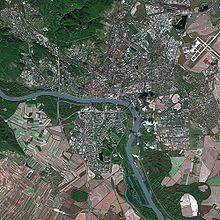
Bratislava on a satellite photo from 2003
Cityscape and architecture

enlarge and show information about the picture
![]()
View of the city from the vantage point of the Slovak National Uprising Bridge: The 360-degree panorama begins in the west with the Most Lafranconi Bridge, showing Bratislava Castle and the Old Town. Further to the right, behind the two bridges Stary Most and Most Apollo, the district Ružinov (German Rosenheim). On the right side of the Danube (location) one looks at the new buildings of Petržalka (German Engerau), behind it the state border to Austria.
Center
Most of the historical buildings are concentrated in the Old Town (Staré Mesto).
The Old Town Hall (Stará radnica), formed by three buildings from the 14th/15th century, is one of the oldest preserved houses in the town. Originally laid out as the residence of the judge in the 14th century, the whole complex now extends over formerly adjacent houses and palaces.
The Baroque Michalská brána (St Michael's Gate) is the only surviving gate of the medieval city fortifications, most of which were demolished in the 18th century by order of Maria Theresa. One section can still be seen to the north of St. Martin's Cathedral. Directly next to the Michaeler Gate stands one of the narrowest houses in Europe (cf. Kirchstrasse 29 (Bregenz)) with a width of 1.30 metres. The Palace of the Hungarian Royal Chamber, built in 1756, housed the Parliament of the Kingdom of Hungary from 1802 to 1848. Since 1953 the house has been the seat of the university library.
Characteristic of the city centre are the numerous palaces in the Baroque style, a cultural heritage of the 18th century. The Grassalkovich Palace (Grasalkovičov palác), built around 1760, is the residence of the President of Slovakia and in the past served Count Antal Grassalkovich I for various balls. During the socialist period it was the Pioneer Palace.
The neighbouring Archbishop's Summer Palace (Letný arcibiskupský palác), built a few years later, which served as the summer residence of the Archbishops of Gran residing in Bratislava in the 17th and 18th centuries, has been the official seat of the Slovak government since 1991. The fourth Peace of Bratislava was signed in 1805 in the Primatial Palace (Primaciálny palác), built in 1781 and now the seat of the mayor. The gallery there exhibits, among other things, six 17th-century English tapestries telling the story of Hero and Leander from Greek mythology. In the Pálffy Palace (Pálfiho palác), built in 1747, Wolfgang Amadeus Mozart, then still six years old, gave a concert. From 1995 to 2012 the building housed the Austrian Embassy.
One of the most famous sacral buildings is St. Martin's Cathedral (Katedrála svätého Martina) from the 13th to 16th centuries, where the kings of the Kingdom of Hungary from the House of Habsburg were crowned from 1563 to 1830. The cathedral received its present Gothic appearance in 1869-1877. Numerous high-ranking personalities are buried in the catacombs, such as members of the Pálffy family or counties of Bratislava, as well as the author of the first Slovak novel, Jozef Ignác Bajza. At the top of the 85-metre-high tower, which was once part of the city's fortifications, is a copy of St Stephen's Crown. The Church of St. Elizabeth (Kostol svätej Alžbety), also known as the "Blue Church" due to the colour of its exterior façade, was built entirely in Art Nouveau style in 1907/1908 and is dedicated to St. Elizabeth of Thuringia. In the Franciscan Church (Františkánsky kostol) from the late 13th century, selected persons were knighted during the coronation ceremonies. Other sacral buildings in the centre are the Gothic Church of the Poor Clares (Kostol klarisiek) from the 14th century with a five-sided tower (now a concert and theatre hall), the Baroque Trinitarian Church (Kostol trinitárov) from the 18th century with rococo interior decoration, and a Modernist-style synagogue from 1923-1926, which is the only one of the former three synagogues still standing.
There are two prominent squares in the inner city centre: the centrally located Main Square (Hlavné námestie), which is surrounded by numerous palaces and town houses as well as the Old Town Hall. Well known are the Kutscherfeldov palác and the Miestodržiteľský palác. In the middle of the square is the Maximilian Fountain, which was built after a great fire during the coronation of Maximilian II. (HRR) in 1563. The square has since become the site of various markets, such as those held at Easter or before Christmas, as well as the venue for the New Year's Eve celebration, which is promoted as "Partyslava". Hviezdoslav Square (Hviezdoslavovo námestie) lies further south and is usually simply called Promenade. Notable buildings include the Slovak National Theatre building, the Reduta, home of the Slovak Philharmonic Orchestra, and the classicist-looking building of the former Hotel Savoy, now Hotel Carlton. The embassies of the USA and Germany are also located here. The square is dominated by the statue of its namesake, the Slovak poet Pavol Országh Hviezdoslav. Among other small bronze statues, there is also one of Hans Christian Andersen.
Among the most photographed attractions in Bratislava are several sculptures created in the last decade of the 20th century. In Rybárska brána, at the corner with Hlavné námestie, there is a statue by Karol Krcmar of Ignác Lamár (1997), the original of Bratislava known as the Beautiful Náci; at the intersection of Rybárska brána and Laurinská, there is Čumil by Viktor Hulík, also created in 1997: Gucker), a worker "peeking" out of a manhole cover below a "Man at work" warning sign, and the sculpture Paparazzi (2001) by Radko Mačuha at the corner of Laurinská and Radničná, which has been in the tower restaurant UFO since 2018.
A curiosity is the restored part of the underground Jewish cemetery, originally at ground level. This is located at the foot of the castle hill near the portal of the tram tunnel. Today it houses the mausoleum of Moses Sofer, a place of pilgrimage for Jews from all over the world. The only military cemetery is Slavín, located on a hill to the west of the Old Town. It was consecrated in 1960 in honour of the soldiers of the Red Army and has a 39.5 metre high obelisk. This cemetery is also a good vantage point.
In the western part of Staré Mesto there is a large villa district covering a large part of the hills above Palisády Street, around Horský Park and Slavín to the Patrónka district.
See also: List of churches in Bratislava and List of palaces in Bratislava
Modern architecture
In the city you can find architecture of functionalist directions, which were predominant in the first Czechoslovak Republic. One of the first buildings in this style was the Umelecká beseda slovenská building from 1925 on Dostojevského rad street and the Lafranconi dormitory on the bank of the Danube. However, it was not until 1930 that modern architecture began to take hold. The emphasis on housing was reflected in projects such as Unitas on Šancová Street and Nová doba on Vajnorská Street. Along the Slovak National Uprising Square are good examples of modernist architecture, such as the Družstevné domy, former Dunaj department store, and the Baťa department store (also Veľký Baťa, now known as Alizé). Not far from it is Bratislava's first skyscraper, colloquially known as Manderlák after its builder, Rudolf Manderla, which became a contemporary dominant. An example of sacral architecture from this period is the Church of the Exaltation of the Holy Cross at Daliborovo námestie in the then independent village of Petržalka. Prominent architects were Milan Michal Harminc, Emil Belluš, Friedrich Weinwurm and Ignác Vécsei.
The New Town Hall on Primaciálne námestie Square opposite the historic Primatial Palace dates from the immediate post-war period. A good example of Socialist Realism is the Mladá garda student hostel on Račianska Street. In the city centre stands the Prior department store (now My Bratislava), built in the 1960s and 1970s, with the Kyjev Hotel on Kamenné námestie Square. The crematorium with urn grove between Lamač and Záhorská Bystrica is considered one of the best examples of post-war Slovak architecture.
Other significant buildings from the 20th century. Other significant buildings from the 20th century include the bridge of the Slovak National Uprising (Most SNP) with a disc-shaped restaurant on the pylon at a height of 85 metres, the headquarters of Slovak Radio resembling an upturned pyramid, the 200-metre-high Kamzík television tower with a viewing platform, the Istropolis trade union building, the New Market Hall on Trnavské mýto Square and the high-rise building of Slovak Television from 1975, which was the tallest building in Czechoslovakia at the time.
The architect Vladimír Dedeček focused his activity in Bratislava and realized projects such as the dormitory in Mlynská dolina, the modern annex of the Slovak National Gallery, the Incheba Exhibition Centre and the buildings of the Supreme Court of the Slovak Republic and the Slovak National Archives.
Residential buildings were built in the 1930s to 1950s mainly in the districts of Staré Mesto, Nové Mesto and Ružinov. From the 1960s to the 1980s, a large number of prefabricated residential buildings were built in Bratislava: In the 1960s these were the districts of Ružinov, Rača, Karlova Ves and Nové Mesto, in the 1970s Dúbravka, Rača, Lamač, Podunajské Biskupice and Petržalka, and in the 1980s Rača, Ružinov, Karlova Ves (in the Dlhé diely district), Vrakuňa, Devínska Nová Ves and Petržalka. Since then, mainly smaller housing projects and roof extensions have been carried out in the existing settlements. Family houses are located mainly in the districts further from the city centre, such as Vajnory, Záhorská Bystrica, Jarovce, Rusovce, Čunovo, Devín and partly Podunajské Biskupice, Vrakuňa and Devínska Nová Ves.
Since the Velvet Revolution, buildings such as the Apollo Bridge and the new Slovak National Theatre building have transformed the cityscape. Since independence, there has been a flurry of construction activity that has transformed the cityscape. One of the first projects to be completed was the new headquarters of the Slovak Bank VÚB in 1997, followed in 2002 by the new building of the National Bank of Slovakia, which at 111 metres was the tallest building in Bratislava until 2019. A notable example of modern development in the wider city centre is the transformation of the old industrial quarter (Brownfield) along Mlynské nivy street and in the Nivy district to the east of the city centre into a district dominated by high-rise buildings, with projects such as Eurovea, Twin City, Panorama City, Sky Park and Tower 115, where Bratislava's tallest building, the Nivy Tower, has stood at 125 metres since 2019. There are plans to build Slovakia's first "real" skyscraper, Eurovea Tower, which will be 168 metres high.
Also on the banks of the Danube, the multi-purpose project River Park was built. Other new urban districts are being built "on greenfield sites", such as Južné mesto and Slnečnice on the southern edge of Petržalka, or Bory on the edge of Dúbravka and Lamač. However, the brisk construction activity is perceived by part of the inhabitants and by architects as "uncoordinated or aggressive". This concerned in particular industrial buildings, which after the decline of industry in inner-city parts in the 2000s and partly in the 2010s, with few exceptions, had to give way to new buildings. Economic interests and a weak awareness of the need to protect industrial architecture are cited as reasons for this development. In the meantime, however, there are also examples that use industrial buildings, such as the spinning mill building of the old twisting factory, or the former combined heat and power plant by architect Dušan Jurkovič.
See also: List of the highest buildings in Bratislava
Bratislava Castle
A landmark of the city is the Bratislava Castle (Bratislavský hrad) west of the Old Town on a rock 85 meters above the Danube. The castle hill was already inhabited by members of the Baden culture during the Copper Age. Later it served as the site of an oppidum of the Celtic Boians, as part of the Roman Danube Limes. It was the core of a fortified settlement of the Slavs and later an important centre of the Great Moravian Empire. A first stone castle existed here already in the 10th century. Emperor Sigismund of Luxembourg had the castle extended to a Gothic-style fortress around 1430. Emperor Ferdinand I ordered the reconstruction in Renaissance style. Around 1650 the castle was given its present baroque appearance. Empress Maria Theresa elevated the castle to her Hungarian residence in 1740. In May 1811 the castle burned to the ground. In the following more than 140 years the ruins stood over the town. From 1953 to 1968 the castle was rebuilt true to the original. Since the end of the 20th century it has been used as a museum and for representative purposes.
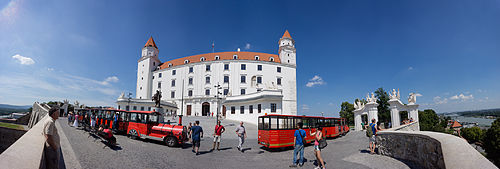
enlarge and show information about the picture
![]()
Bratislava Castle - Panorama
Devín Castle
The ruins of Devín Castle (Devínsky hrad) are located in the Devín district on a rock above the confluence of the Morava River and the Danube on the Slovak-Austrian border. Due to its strategic location, Devín was an important border fortification of the Great Moravian Empire and the early Hungarian state. The castle was blown up by Napoleonic troops in 1809, but subsequently became an important symbol of Slovak national consciousness. Today it is one of the most important archaeological sites in the country and part of an open-air museum.
Rusovce
The castle of Karlburg (Rusovský kaštieľ) with its English landscape park is located in the Rusovce district south of the city centre. The building had originated in the 16th century and was rebuilt into a neo-Gothic country estate in the English style in 1841-1844. Rusovce is also known as the site of the ruins of the Roman fort of Gerulata, which was occupied from the 1st to the 4th century and formed part of the Danube Limes.
Parks and lakes
Due to its location at the foot of the Little Carpathians and its proximity to the Danube floodplain, Bratislava has forests that reach almost to the city centre. The largest city park is Horský park (German: Gebirgspark) in the old town. Bratislavský lesný park (Bratislava Forest Park) is a popular destination in the Little Carpathians. It covers an area of 27.3 km² (96 percent of which is forested) and has much original fauna and flora such as badgers, red foxes and European mouflons. On the right bank of the Danube, in Petržalka, is the Janko Kráľ Park (Sad Janka Kráľa), established in 1774-1776, one of the oldest publicly accessible parks in Europe. A new city park is planned in Petržalka between the Malý Draždiak and Veľký Draždiak lakes.
The Zoological Garden (Bratislavská zoologická záhrada) is located in Mlynská dolina (Mill Valley), near the headquarters of Slovak Television. Founded in 1960, the zoo displays more than 150 species of animals. The Botanical Garden at the mouth of the Vydrica River into the Danube, run by Comenius University, has almost 4000 plant species.
There are numerous natural and man-made lakes in the city area, most of which are publicly accessible recreational areas. Examples are the Štrkovecké jazero (Bull's Dew) in Ružinov, the Kuchajda (Cow's Heath) in Nové Mesto, Zlaté piesky (literally Golden Sands) and the Vajnorské jazerá (literally Vajnory Lakes) in the northeast and several lakes in Rusovce in the south.
A curiosity is the sand mountain in Devínska Nová Ves; it is formed by the rock remains of the Tertiary sea and is a site of various fossils of marine life.
Cemeteries
There are about 35 cemeteries in the town, besides the already above mentioned Slavín cemetery and Chatam Sofer mausoleum, they include, among others, St. Andrew's cemetery, Gaistor cemetery, Slávičie údolie cemetery and the crematorium and urn grove between Lamač and Záhorská Bystrica. In the Vrakuňa cemetery there is a German military cemetery where about 980 German soldiers are buried.
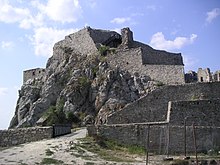
Devín Castle
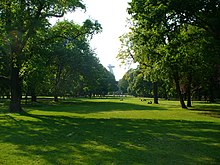
Janko Kráľ Park in Petržalka, one of the oldest public parks in Europe
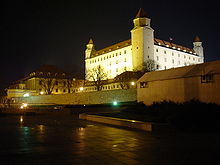
Bratislava Castle by night

Elisabeth Church, (also called "Blue Church") Art Nouveau by Ödön Lechner
.jpg)
Functionalist department store Veľký Baťa
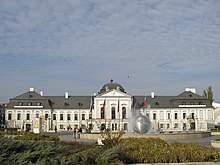
Grassalkovich Palace, Presidential Residence
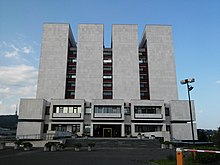
Slovak National Archives
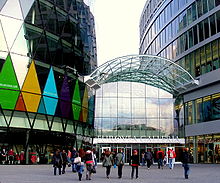
Modern shopping centre Eurovea
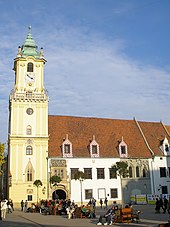
Old town hall on the main square
Questions and Answers
Q: What is Bratislava?
A: Bratislava is the capital city of Slovakia.
Q: How many people live in Bratislava?
A: About 450,000 people live in Bratislava.
Q: What were some other names for Bratislava in the past?
A: Bratislava used to be called Pressburg (German) or Pozsony (Hungarian) and by some other names.
Q: What is the seat of the national government, the presidency, and the parliament in Bratislava?
A: Bratislava is the seat of the national government, the presidency, and the parliament.
Q: What are some institutions in Bratislava?
A: Bratislava has several museums, galleries, and other educational, cultural, and economic institutions.
Q: Does Bratislava have an Old Town?
A: Yes, there is a small Old Town in Bratislava.
Q: What river goes through Bratislava?
A: The Danube river goes through Bratislava.
Search within the encyclopedia